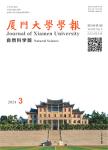Study on Microcrystaline Structure and Luminescence of ZnS Thin Film Devices
Study on Microcrystaline Structure and Luminescence of ZnS Thin Film Devices出 版 物:《厦门大学学报(自然科学版)》 (Journal of Xiamen University:Natural Science)
年 卷 期:2002年第41卷第S1期
页 面:176-177页
核心收录:
基 金:ProjectsupportedbyNaturalScienceFundationofFujianProvince (0 1 1 0 0 0 66)
主 题:electroluminescence ZnS thin film microstru cture
摘 要:The Electroluminescence thin films of zinc sulfide do ped with erbium, fabricated by thermal evaporation with two boats, are analyzed by the technology of X-ray diffraction (XRD) and X-ray photoelectron spectrosc opy (XPS). The relationship between electroluminescence brightness and microst ructure of the thin films is obtained. The analysis results of XRD indicate th at the fabricated zinc sulfide thin films belong to the blende structure and hav e a trend of preferential orientation. The XPS measurements reveal the surface m icrostructure states formed mainly by oxygen absorption and carbon absorption th at effect on the EL excitation and relaxation luminescence process. The maximum photoelectron peak corresponding to the doped erbium is detected at a depth of 1 35nm to 350nm that formed the activation layer in the films. Analysis shows that the high brightness of the film devices is attributed to the crystalline planes of growth orientated in the (311), (400). In explanation of this phenomenon, th e status of the substitute energy for Er 3+ replacing Zn 2+ in the hos t lattice of zinc sulfide is discussed. All results of describing above are referable in researching of the electroluminescence excitation machnism of the t hin film devices and in favor of fabricating the thin film devices with high qua lity.



